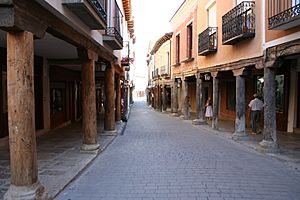Medina de Rioseco facts for kids
Quick facts for kids
Medina de Rioseco
|
|||
|---|---|---|---|
|
|||
| Nickname(s):
City of the Admirals
|
|||
| Country | |||
| Autonomous community | |||
| Province | Valladolid | ||
| Municipality | Medina de Rioseco | ||
| Area | |||
| • Total | 115 km2 (44 sq mi) | ||
| Elevation | 741 m (2,431 ft) | ||
| Population
(2018)
|
|||
| • Total | 4,716 | ||
| • Density | 41.01/km2 (106.2/sq mi) | ||
| Time zone | UTC+1 (CET) | ||
| • Summer (DST) | UTC+2 (CEST) | ||
| Website | www.medinaderioseco.com/ | ||
Medina de Rioseco is a town in Spain. It is located in the province of Valladolid, which is part of the Castile and León region. In 2018, about 4,716 people lived there.
This town is sometimes called the "City of the Admirals." It is also known as "Old India Girl." Medina de Rioseco covers an area of about 115 square kilometers (44 square miles). The Sequillo river flows nearby. The town is also on the famous Camino de Santiago route from Madrid.
The town's official symbol, its coat of arms, shows two gold castles and two horses. These symbols were given to the town by King John I of Castile a long time ago.
Contents
How Medina de Rioseco Began
The first signs of people living in Rioseco date back to the Iron Age. This was a time when people used iron tools. Some old writers thought this area might have been a market during the Visigoths' time. Documents from that period mention the "Tierra de Campos," which means "Land of Fields."
In the 800s and 900s, the Asturian-Leonese kingdom started to settle this area. People called Mozarabs also lived here. Mozarabs were Christians who lived under Arab rule in Al-Andalus (parts of Spain ruled by Muslims). This might be why the town's name includes "Medina," which is an Arabic word for "city."
The Reconquest and Borders
The area where Medina de Rioseco is located was often a border between the Kingdom of León and the County of Castile. This led to many battles between these two kingdoms. In 1037, Castile became its own separate kingdom.
Later, in 1258, King Alfonso X the Wise set the final borders with Valladolid. Medina de Rioseco was then part of the mountains of Torozos. During the Middle Ages, Medina de Rioseco was part of an administrative area called the Merindad of Valladolid Infantazgo. This was a division of the Kingdom of Castile.
The Admirals of Castile
In 1405, a person named Don Alonso Enriquez was given the important title of Admiral of Castile. This title was given by King Henry III of Castile. Later, in 1423, King John II of Castile made Medina de Rioseco a special area ruled by the Admiral.
Medina de Rioseco had always been a place for trade. This became even more official over time. The second Admiral, D. Fadrique Enriquez, was given permission by King John II to hold a yearly fair in the town.
More Rights for the Town
Under the third Admiral, Alfonso II Enriquez, the town received even more rights. King Enrique IV of Castile allowed Medina de Rioseco to hold a second yearly fair. In 1465, the town was also given the right to have a weekly market without paying taxes.
The fourth Admiral, Don Frederic II and Enríquez de Cabrera, started building important structures. These included the palace of the admirals and the church of San Francisco. He also helped build the convent of Santa Clara and the church of Santa María de Mediavilla.
A Busy Trading Center in the 1500s
In the 1500s, Medina de Rioseco became a very important place for trade. Silver from the Americas arrived through the port of Seville and then came to Medina de Rioseco. This made the town very rich.
Many gifts and money came from the Americas, making the city and its churches wealthier. Four large churches were built in Rioseco during this time. The city also became home to one of the most important fairs in the kingdom. It was second only to the fair in Medina del Campo. During this period, special monasteries were also founded. They were known for their religious parades and had many chapels and hospitals.
A famous battle, the Battle of Medina del Rio Seco, happened here on July 14, 1808. This battle was part of the Peninsular War.
Pictures of Santiago Apóstol Church
See also
 In Spanish: Medina de Rioseco para niños
In Spanish: Medina de Rioseco para niños

















